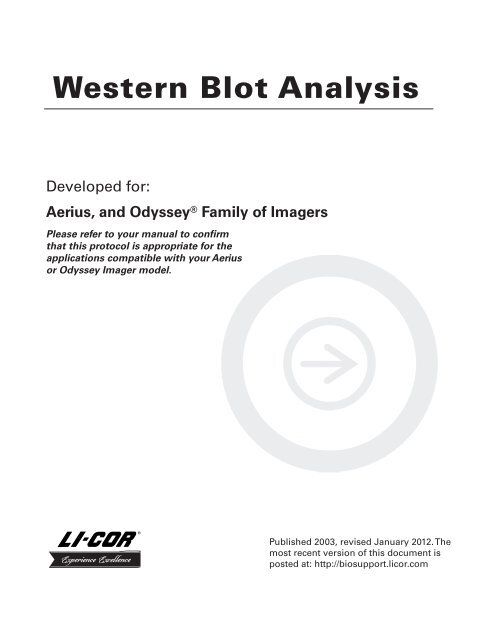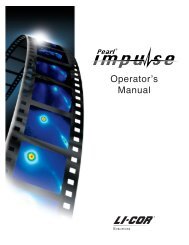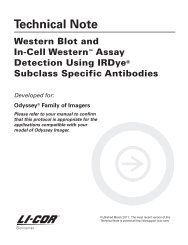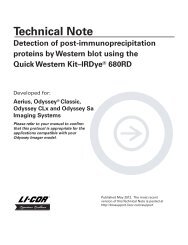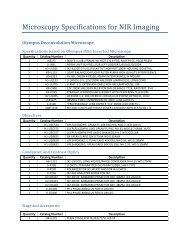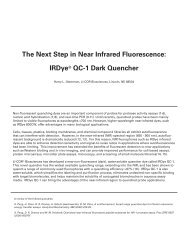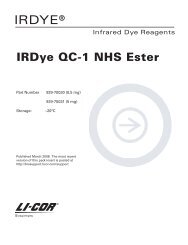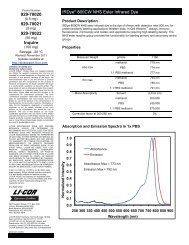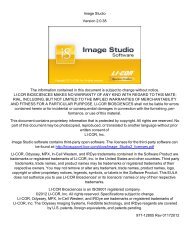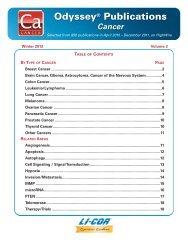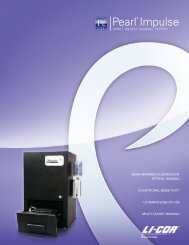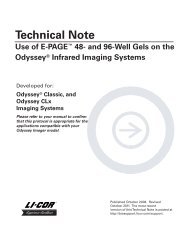Western Blot Analysis - LI-COR Bio Technical Resources Library - LI ...
Western Blot Analysis - LI-COR Bio Technical Resources Library - LI ...
Western Blot Analysis - LI-COR Bio Technical Resources Library - LI ...
Create successful ePaper yourself
Turn your PDF publications into a flip-book with our unique Google optimized e-Paper software.
<strong>Western</strong> <strong>Blot</strong> <strong>Analysis</strong><br />
Developed for:<br />
Aerius, and Odyssey ® Family of Imagers<br />
Please refer to your manual to confirm<br />
that this protocol is appropriate for the<br />
applications compatible with your Aerius<br />
or Odyssey Imager model.<br />
Published 2003, revised January 2012. The<br />
most recent version of this document is<br />
posted at: http://biosupport.licor.com
Page 2 – <strong>Western</strong> <strong>Blot</strong> <strong>Analysis</strong><br />
Table of Contents<br />
I.<br />
Page<br />
Required Reagents . . . . . . . . . . . . . . . . . . . . . . . . . . . . . . . . . . . . . . . . . .2<br />
II. <strong>Western</strong> Detection Methods . . . . . . . . . . . . . . . . . . . . . . . . . . . . . . . . . .2<br />
III. Guidelines for Two-Color Detection . . . . . . . . . . . . . . . . . . . . . . . . . . . .5<br />
IV. Stripping the Membrane . . . . . . . . . . . . . . . . . . . . . . . . . . . . . . . . . . . . .6<br />
V. Adapting <strong>Western</strong> <strong>Blot</strong>ting Protocols for Odyssey ® Detection . . . . . .6<br />
VI. General Tips . . . . . . . . . . . . . . . . . . . . . . . . . . . . . . . . . . . . . . . . . . . . . . .7<br />
VII. Imaging of Coomassie-Stained Protein Gels . . . . . . . . . . . . . . . . . . . . .8<br />
VIII. Troubleshooting Guide . . . . . . . . . . . . . . . . . . . . . . . . . . . . . . . . . . . . . .9<br />
I. Required Reagents<br />
<strong>Blot</strong>ted nitrocellulose (<strong>LI</strong>-<strong>COR</strong>, P/N 926-31090) or low-fluorescent PVDF membrane<br />
(<strong>LI</strong>-<strong>COR</strong>, P/N 926-31098)<br />
Odyssey Blocking Buffer (<strong>LI</strong>-<strong>COR</strong>, P/N 927-40000)<br />
Odyssey Pre-stained Molecular Weight Marker (<strong>LI</strong>-<strong>COR</strong>, P/N 928-40000)<br />
IRDye (680/800) Protein Markier (<strong>LI</strong>-<strong>COR</strong>, P/N 928-40006)<br />
Primary antibodies<br />
IRDye ® secondary antibodies (<strong>LI</strong>-<strong>COR</strong>)<br />
Tween ® 20<br />
PBS wash buffer (<strong>LI</strong>-<strong>COR</strong>, P/N 928-40018 or 928-40020)<br />
Ultrapure water<br />
Methanol for wetting of PVDF<br />
SDS (if desired)<br />
Other blocking buffers (if desired)<br />
New<strong>Blot</strong> Stripping Buffer, if desired, for nitrocellulose (<strong>LI</strong>-<strong>COR</strong>, P/N 928-40030)<br />
or PVDF (<strong>LI</strong>-<strong>COR</strong>, P/N 928-40032) membranes<br />
II. <strong>Western</strong> Detection Methods<br />
Nitrocellulose or PVDF membranes may be used for protein blotting. Pure cast nitrocellulose is<br />
generally preferable to supported nitrocellulose. Protein should be transferred from gel to membrane<br />
by standard procedures. Membranes should be handled only by their edges, with clean<br />
forceps.<br />
After transfer, perform the following steps:<br />
1. Wet the membrane in PBS for several minutes. If using a PVDF membrane that has been<br />
allowed to dry, pre-wet briefly in 100% methanol and rinse with ultrapure water before incubating<br />
in PBS.<br />
NOTES:<br />
Ink from most pens and markers will fluoresce on all Aerius or Odyssey Imagers. The ink<br />
may wash off and re-deposit elsewhere on the membrane, creating blotches and streaks.<br />
Pencil should be used to mark membranes. (The Odyssey pen doesn’t fluoresce and can<br />
be used with nitrocellulose membranes, since the membrane will not be soaked in<br />
methanol, causing the ink to run.)
<strong>Western</strong> <strong>Blot</strong> <strong>Analysis</strong> – Page 3<br />
2. Block the membrane in Odyssey ® Blocking Buffer for 1 hour. Be sure to use sufficient blocking<br />
buffer to cover the membrane (a minimum of 0.4 mL/cm 2 is suggested).<br />
NOTES:<br />
Membranes can be blocked overnight at 4°C if desired.<br />
Odyssey Blocking Buffer often yields higher and more consistent sensitivity and performance<br />
than other blockers. Nonfat dry milk or casein dissolved in PBS can also be used for<br />
blocking and antibody dilution, but be aware that milk may cause higher background on<br />
PVDF membranes. If using casein, a 0.1% solution in 0.2X PBS buffer is recommended<br />
(Hammersten-grade casein is not required).<br />
Milk-based reagents can interfere with detection when using anti-goat antibodies. They<br />
also deteriorate rapidly at 4°C, so diluted antibodies should not be kept and re-used.<br />
Blocking solutions containing BSA can be used, but in some cases they may cause high<br />
membrane background. BSA-containing blockers are not generally recommended and<br />
should be used only when the primary antibody requires BSA as blocker.<br />
3. Dilute primary antibody in Odyssey Blocking Buffer. Optimum dilution depends on the antibody<br />
and should be determined empirically. A suggested starting range can usually be found<br />
in the product information from the vendor. To lower background, add 0.1 - 0.2% Tween ® 20<br />
to the diluted antibody before incubation. The optimum Tween 20 concentration will depend<br />
on the antibody.<br />
NOTES:<br />
Two-color detection requires careful selection of primary and secondary antibodies. For<br />
details, see III. Guidelines for Two Color <strong>Western</strong> Detection.<br />
The MPX <strong>Blot</strong>ting System can be used to efficiently determine the optimum antibody<br />
concentration. For details, search for One <strong>Blot</strong> <strong>Western</strong> Optimization Using the MPX<br />
<strong>Blot</strong>ting System at http://biosupport.licor.com.<br />
4. Incubate blot in primary antibody for 60 minutes or longer at room temperature with gentle<br />
shaking. Optimum incubation times vary for different primary antibodies. Use enough antibody<br />
solution to completely cover the membrane.<br />
5. Wash membrane 4 times for 5 minutes each at room temperature in PBS + 0.1% Tween 20<br />
with gentle shaking, using a generous amount of buffer.<br />
6. Dilute the fluorescently-labeled secondary antibody in Odyssey Blocking Buffer. Recommended<br />
dilution can be found in the pack insert for the IRDye ® conjugate. Add the same<br />
amount of Tween 20 to the diluted secondary antibody as was added to the primary antibody.<br />
NOTES:<br />
Avoid prolonged exposure of the antibody vial to light.<br />
Be careful not to introduce contamination into the antibody vial.<br />
For best sensitivity and performance, use freshly diluted antibody solution.<br />
Adding 0.01% - 0.02% SDS to the diluted secondary antibody (in addition to Tween 20) will<br />
substantially reduce membrane background, particularly when using PVDF. However, DO<br />
NOT add SDS during blocking or to the diluted primary antibody. See V. Adapting <strong>Western</strong><br />
<strong>Blot</strong>ting Protocols for Odyssey Detection for more information about how and why to<br />
use SDS in the secondary antibody incubation.<br />
The MPX <strong>Blot</strong>ting System can be used to efficiently determine the optimum antibody<br />
concentration. For details, search for One <strong>Blot</strong> <strong>Western</strong> Optimization Using the MPX<br />
<strong>Blot</strong>ting System at http://biosupport.licor.com.
Page 4 – <strong>Western</strong> <strong>Blot</strong> <strong>Analysis</strong><br />
7. Incubate blot in secondary antibody for 30-60 minutes at room temperature with gentle shaking.<br />
Protect from light during incubation.<br />
NOTES:<br />
Incubating more than 60 minutes may increase background.<br />
8. Wash membrane 4 times for 5 minutes each at room temperature in PBS + 0.1% Tween ® 20<br />
with gentle shaking. Protect from light.<br />
9. Rinse membrane with PBS to remove residual Tween 20. The membrane is now ready to scan.<br />
10. Image on Aerius, or Odyssey ® Family of Imagers.<br />
Scan in the appropriate channels.<br />
Protect the membrane from light until it has been imaged.<br />
Keep the membrane wet to strip and re-use it. Once a membrane has dried, stripping is<br />
ineffective.<br />
<strong>Blot</strong>s can be allowed to dry before scanning, if desired. Signal strength may be enhanced<br />
on a dry membrane. The membrane can also be re-wetted for imaging.<br />
The fluorescent signal on the membrane will remain stable for several months, or longer,<br />
if protected from light. Membranes may be stored dry at 4°C.<br />
If signal on membrane is too strong or too weak, re-image the membrane at a lower or<br />
higher scan intensity setting, respectively. Adjust image acquisition time for Odyssey Fc.<br />
AutoMode in Odyssey CLx may be used to improve the dynamic range of the image.<br />
Molecular Weight Marker<br />
If you loaded the Odyssey Prestained Molecular Weight Marker (<strong>LI</strong>-<strong>COR</strong>, P/N 928-40000), it will be<br />
visible in the 700 nm channel and also faintly visible in the 800 nm channel. If using IRDye (680/800)<br />
Protein Marker, it will be visible in both the 700 nm and 800 nm channels. Pre-stained blue molecular<br />
weight markers from other sources can also be used. Load 1/3 to 1/5 of the amount you<br />
would normally use for <strong>Western</strong> transfer. Too much marker can result in very strong marker<br />
bands that may interfere with visualization of sample lanes. If using multicolored markers, some<br />
bands may not be visualized.<br />
Optimization Tips<br />
1. Follow the protocol carefully.<br />
2. No single blocking reagent will be optimal for every antigen-antibody pair. Some primary antibodies<br />
may exhibit greatly reduced signal or different non-specific binding in different blocking<br />
solutions. If it is difficult to detect the target protein, changing the blocking solution may<br />
dramatically improve performance. If the primary antibody has worked well in the past using<br />
chemiluminescent detection, try that blocking solution for infrared detection.<br />
3. Addition of detergent such as Tween ® 20 can reduce membrane background and non-specific<br />
binding. Refer to V. Adapting <strong>Western</strong> <strong>Blot</strong>ting Protocols for Odyssey Detection for details.<br />
4. To avoid background speckles on blots, use ultrapure water for buffers and rinse plastic<br />
dishes well before and after use. Never perform <strong>Western</strong> incubations or washes in dishes that<br />
have been used for Coomassie staining.<br />
5. Membranes should be handled only by their edges, with clean forceps.
6. After handling membranes that have been incubating in antibody solutions, clean forceps<br />
thoroughly with distilled water and/or ethanol. If forceps are not cleaned after being dipped in<br />
antibody solutions, they can cause spots or streaks of fluorescence on the membrane that are<br />
difficult to wash away.<br />
7. Do not wrap the membrane in plastic when scanning.<br />
8. If a <strong>Western</strong> blot will be stripped, do not allow the membrane to dry. Stripping is ineffective<br />
once a membrane has dried, or even partially dried.<br />
III. Guidelines for Two-Color Detection<br />
Two different antigens can be detected simultaneously on the same blot using antibodies labeled<br />
with near-infrared dyes that are visualized in different fluorescence channels (700 and 800 nm).<br />
Two-color detection requires careful selection of primary and secondary antibodies.<br />
The following guidelines will help design two-color experiments:<br />
<strong>Western</strong> <strong>Blot</strong> <strong>Analysis</strong> – Page 5<br />
1. If the two primary antibodies are derived from different host species (for example, primary<br />
antibodies from mouse and chicken), IRDye ® whole IgG secondary antibodies derived from<br />
the same host and labeled with different IRDye fluorophores must be used (for example,<br />
IRDye 800CW Donkey anti-Mouse and IRDye 680LT or IRDye 680RD Donkey anti-Chicken).<br />
2. If the two primary antibodies are monoclonals (mouse) and are IgG 1 , IgG 2a , or IgG 2b , IRDye<br />
Subclass Specific secondary antibodies must be used. The same subclasses cannot be combined<br />
in a two-color <strong>Western</strong> blot (for example, two IgG 1 primary antibodies). For details,<br />
refer to <strong>Western</strong> <strong>Blot</strong> and In-Cell <strong>Western</strong> Assay Detection Using IRDye Subclass Specific<br />
Antibodies.<br />
3. Before combining primary antibodies in a two-color experiment, always perform preliminary<br />
blots with each primary antibody alone to determine the expected banding pattern and possible<br />
background bands. Slight cross-reactivity may occur and can complicate interpretation of<br />
a blot, particularly if the antigen is very abundant. If cross-reactivity is a problem, load less<br />
protein or reduce the amount of antibody.<br />
4. One secondary antibody must be labeled with a 700 nm channel dye, and the other with an<br />
800 nm channel dye.<br />
5. Always use highly cross-adsorbed secondary antibodies for two-color detection. Failure to<br />
use highly cross-adsorbed antibodies may result in cross-reactivity.<br />
6. For best results, avoid using primary antibodies from mouse and rat together for a two-color<br />
experiment. It is not possible to completely adsorb away cross-reactivity because the species<br />
are so closely related. If using mouse and rat together, it is crucial to run single-color blots<br />
first with each individual antibody to be certain of expected band sizes.
Page 6 – <strong>Western</strong> <strong>Blot</strong> <strong>Analysis</strong><br />
When performing a two-color blot, use the standard <strong>Western</strong> blot protocol with the following<br />
modifications:<br />
Combine the two primary antibodies in the diluted antibody solution in step 3. Incubate<br />
simultaneously with the membrane (step 4).<br />
Combine the two dye-labeled secondary antibodies in the diluted antibody solution in<br />
step 6. Incubate simultaneously with the membrane (step 7).<br />
IV. Stripping the Membrane<br />
Typically, both PVDF and nitrocellulose membranes can be stripped up to three times. <strong>LI</strong>-<strong>COR</strong> ®<br />
New<strong>Blot</strong> Stripping Buffer is available under P/N 928-40030 for nitrocellulose or 928-40032 for<br />
PVDF. If a blot is to be stripped, DO NOT allow it to dry before, during, or after imaging (keep the<br />
blot as wet as possible). Complete usage instructions are given in the New<strong>Blot</strong> Stripping Buffer<br />
pack insert that is shipped with the product. Before proceeding, read the instructions in the pack<br />
insert, including the frequently asked questions.<br />
V. Adapting <strong>Western</strong> <strong>Blot</strong>ting Protocols for Detection with Odyssey ®<br />
Systems<br />
When adapting <strong>Western</strong> blotting protocols for Odyssey detection or using a new primary antibody,<br />
it is important to determine the optimal antibody concentrations. Optimization will help<br />
achieve maximum sensitivity and consistency. Three parameters should be optimized: primary<br />
antibody concentration, dye-labeled secondary antibody concentration, and detergent concentration<br />
in the diluted antibodies.<br />
Primary Antibody Concentration<br />
Primary antibodies vary widely in quality, affinity, and concentration. The correct working range<br />
for antibody dilution depends on the characteristics of the primary antibody and the amount of<br />
target antigen to detect. Suggested dilutions are 1:500, 1:1500, 1:5000, and 1:10,000 (start with<br />
the dilution factor normally used for chemiluminescent detection, or refer to the product information<br />
from the vendor). Use the MPX <strong>Blot</strong>ting System to optimize the primary dilution to achieve<br />
maximum performance and conserve antibody (refer to One <strong>Blot</strong> <strong>Western</strong> Optimization Using<br />
the MPX <strong>Blot</strong>ting System at http://biosupport.licor.com).<br />
Secondary Antibody Concentration<br />
Optimal dilutions of dye-conjugated secondary antibodies should also be determined. Refer<br />
to the IRDye ® conjugate pack insert for recommendations. The amount of secondary required<br />
varies depending on how much antigen is being detected – abundant proteins with strong signals<br />
require less secondary antibody. Use the MPX <strong>Blot</strong>ting system to optimize (search for One<br />
<strong>Blot</strong> <strong>Western</strong> Optimization Using the MPX <strong>Blot</strong>ting System at http://biosupport.licor.com).<br />
Detergent Concentration<br />
Addition of detergents to diluted antibodies can significantly reduce background on the blot.<br />
Optimal detergent concentration will vary, depending on the antibodies, membrane type, and<br />
blocker used. Keep in mind that some primaries do not bind as tightly as others and may be<br />
washed away by too much detergent. Never expose the membrane to detergent until blocking<br />
is complete, as this may cause high membrane background.
Tween ® 20:<br />
Add Tween 20 to both the primary antibody and secondary antibody solutions when the<br />
antibodies are diluted in blocking buffer. A final concentration of 0.1 - 0.2% is recommended<br />
for nitrocellulose membranes, and a final concentration of 0.1% is recommended<br />
for PVDF membranes (higher concentrations of Tween 20 may actually cause increased<br />
background on PVDF).<br />
Wash solutions should contain 0.1% Tween 20.<br />
SDS:<br />
<strong>Western</strong> <strong>Blot</strong> <strong>Analysis</strong> – Page 7<br />
Adding 0.01 - 0.02% SDS to the diluted secondary antibody can dramatically reduce overall<br />
membrane background and also reduce or eliminate non-specific binding. It is critical to<br />
use only a very small amount, because SDS is an ionic detergent and can disrupt antigenantibody<br />
interactions if too much is present at any time during the detection process.<br />
Addition of SDS is particularly helpful for reducing the higher overall background that<br />
is seen with PVDF membrane. When working with IRDye ® 680LT conjugates on PVDF<br />
membranes, SDS (final concentration of 0.01 - 0.02%) and Tween 20 (final concentration<br />
of 0.1 - 0.2%) must be added during detection incubation step to avoid non-specific back<br />
ground staining.<br />
DO NOT add SDS during the blocking step or to the diluted primary antibody. Presence of<br />
SDS during binding of the primary antibody to its antigen may greatly reduce signal. Add<br />
SDS only to the diluted secondary antibody.<br />
Wash solutions should contain 0.1% Tween 20, but no SDS.<br />
Some antibody-antigen pairs may be more sensitive to the presence of SDS and may require<br />
even lower concentrations of this detergent (less than 0.01%) for best performance.<br />
Titrate the amount of SDS to find the best level for the antibodies used.<br />
If high background is seen when using BSA-containing blocking buffers, adding SDS to the<br />
secondary antibody may alleviate the problem.<br />
VI. General Tips<br />
1. Milk-based blockers may contain IgG that can cross-react with anti-goat antibodies. This can<br />
significantly increase background and reduce antibody titer. Milk may also contain endogenous<br />
biotin or phospho-epitopes that can cause higher background.<br />
2. Store the IRDye secondary antibody vial at 4°C in the dark. IRDye secondary antibodies may<br />
be aliquoted and frozen for long-term storage. Minimize exposure to light and take care not to<br />
introduce contamination into the vial. Dilute immediately prior to use. If particulates are seen<br />
in the antibody solution, centrifuge before use.<br />
3. Protect membrane from light during secondary antibody incubations and washes.<br />
4. Use the narrowest well size possible for the loading volume to concentrate the target protein.<br />
5. The best transfer conditions, membrane, and blocking agent for experiments will vary, depending<br />
on the antigen and antibody. If there is high background or low signal level, a good<br />
first step is to try a different blocking solution.<br />
6. Small amounts of purified protein may not transfer well. Adding non-specific proteins of similar<br />
molecular weight can have a “carrier” effect and substantially increase transfer efficiency.
Page 8 – <strong>Western</strong> <strong>Blot</strong> <strong>Analysis</strong><br />
7. For proteins
VIII. Troubleshooting Guide<br />
<strong>Western</strong> <strong>Blot</strong> <strong>Analysis</strong> – Page 9<br />
Problem Possible Cause Solution / Prevention<br />
High background, BSA used for blocking. Blocking solutions containing BSA<br />
uniformly distributed. may cause high membrane back<br />
ground. Try adding SDS to reduce<br />
background, or switch to a different<br />
blocker.<br />
Not using optimal blocking Compare different blocking buffers to<br />
reagent. find the most effective; try blocking<br />
longer.<br />
Background on nitrocellulose. Add Tween ® 20 to the diluted antibodies<br />
to reduce background. Try<br />
adding SDS to diluted secondary antibody.<br />
Background on PVDF. Use low-fluorescent PVDF membrane.<br />
With IRDye ® 680LT conjugates, always<br />
use SDS (0.01-0.02% final concentration)<br />
and Tween 20 (0.1-0.2% final) during<br />
the detection incubation step.<br />
Antibody concentrations Optimize primary and secondary antitoo<br />
high. body dilutions using MPX blotting<br />
system. For details, see One <strong>Blot</strong><br />
<strong>Western</strong> Optimization Using the MPX<br />
<strong>Blot</strong>ting System at<br />
http://biosupport.licor.com<br />
Insufficient washing. Increase number of washes and<br />
buffer volume.<br />
Make sure that 0.1% Tween 20 is present<br />
in buffer and increase if needed.<br />
Note that excess Tween 20 (0.5-1%)<br />
may decrease signal.<br />
Cross-reactivity of antibody Use Odyssey Blocking Buffer instead<br />
with contaminants in blocking of milk. Milk usually contains IgGs that<br />
cross-react with anti-goat secondary<br />
antibodies.<br />
Inadequate antibody volume Increase antibody volume so entire<br />
used. membrane surface is sufficiently covered<br />
with liquid at all times (use heatseal<br />
bags if volume is limiting). Do not<br />
allow any area of membrane to dry out.<br />
Use agitation for all antibody incubations.<br />
Membrane contamination. Always handle membranes carefully<br />
and with clean forceps. Do not allow<br />
membrane to dry. Use clean dishes,<br />
bags, or trays for incubations.
Page 10 – <strong>Western</strong> <strong>Blot</strong> <strong>Analysis</strong><br />
Problem Possible Cause Solution / Prevention<br />
Uneven blotchy or Blocking multiple membranes If multiple membranes are being<br />
speckled background. together in small volume. blocked in the same dish, ensure that<br />
blocker volume is adequate for all<br />
membranes to move freely and make<br />
contact with liquid.<br />
Membrane not fully wetted or Keep membrane completely wet at all<br />
allowed to partially dry. times. This is particularly crucial if blot<br />
will be stripped and re-used.<br />
If using PVDF, remember to first prewet<br />
in 100% methanol.<br />
Contaminated forceps Always carefully clean forceps after<br />
or dishes. they are dipped into an antibody solution,<br />
particularly dye-labeled secondary<br />
antibody. Dirty forceps can deposit<br />
dye on the membrane that will<br />
not wash away.<br />
Use clean dishes, bags or trays for incubations.<br />
Dirty scanning surface or Clean scanning surface and mat caresilicone<br />
mat. fully before each use. Dust, lint, and<br />
residue will cause speckles.<br />
Incompatible marker or pen Use only pencil or Odyssey ® pen (niused<br />
to mark membrane. trocellulose only) to mark membranes.<br />
Weak or no signal. Not using optimal blocking Primary antibody may perform subreagent.<br />
stantially better with a different<br />
blocker.<br />
Insufficient antibody used. Primary antibody may be of low affinity.<br />
Increase amount of antibody or try<br />
a different source.<br />
Extend primary antibody incubation<br />
time (try 4 - 8 hr at room temperature,<br />
or overnight at 4°C).<br />
Increase amount of primary or secondary<br />
antibody, optimizing for best<br />
performance.<br />
Try substituting a different dyelabeled<br />
secondary antibody.<br />
Primary or secondary antibody may<br />
have lost reactivity due to age or storage<br />
conditions.<br />
Too much detergent present; Decrease Tween ® 20 and/or SDS in disignal<br />
being washed away. luted antibodies. Recommended SDS<br />
concentration is 0.01 - 0.02%, but<br />
some antibodies may require an even<br />
lower concentration.
<strong>Western</strong> <strong>Blot</strong> <strong>Analysis</strong> – Page 11<br />
Problem Possible Cause Solution / Prevention<br />
Weak or no signal. Insufficient antigen loaded. Load more protein on the gel. Try<br />
(Continued) using the narrowest possible well size<br />
to concentrate antigen.<br />
Protein did not transfer well. Check transfer buffer choice and blotting<br />
procedure.<br />
Use pre-stained molecular weight<br />
marker to monitor transfer, and stain<br />
gel after transfer to make sure proteins<br />
are not retained in gel.<br />
Protein lost from membrane Extended blocking times or high conduring<br />
detection. centrations of detergent in diluted antibodies<br />
may cause loss of antigen<br />
from the blotted membrane.<br />
Proteins not retained on Allow membrane to air dry commembrane<br />
during transfer. pletely (1 - 2 hr) after transfer. This<br />
helps make the binding irreversible.<br />
Addition of 20% methanol to transfer<br />
buffer may improve antigen binding.<br />
Note: Methanol decreases pore size of<br />
gel and can hamper transfer of large<br />
proteins.<br />
SDS in transfer buffer may interfere<br />
with binding of transferred proteins,<br />
especially for low molecular weight<br />
proteins. Try reducing or eliminating<br />
SDS. Note: Presence of up to 0.05%<br />
SDS does improve transfer efficiency<br />
of some proteins.<br />
Small proteins may pass through membrane<br />
during transfer (“blow-through”).<br />
Use membrane with smaller pore size<br />
or reduce transfer time.<br />
Non-specific or Antibody concentrations too Reduce the amount of antibody used.<br />
unexpected bands. high. Reduce antibody incubation times.<br />
Increase Tween ® 20 in diluted antibodies.<br />
Add or increase SDS in diluted secondary<br />
antibodies.<br />
Not using optimal blocking Choice of blocker may affect backreagent.<br />
ground bands. Try a different blocker.<br />
Cross-reactivity between Double-check the sources and speciantibodies<br />
in a two-color ficities of the primary and secondary<br />
experiment. antibodies used (see III. Guidelines for<br />
Two-Color Detection).<br />
Use only highly cross-adsorbed secondary<br />
antibodies.
Cause Possible Cause Solution / Prevention<br />
Non-specific or There is always potential for cross-reunexpected<br />
bands. activity in two-color experiments. Use<br />
(Continued) less secondary antibody to minimize.<br />
Always test the two colors on separate<br />
blots first so you know what<br />
bands to expect and where.<br />
Avoid using mouse and rat antibodies<br />
together, if possible. Because the<br />
species are so closely related, antimouse<br />
will react with rat IgG to some<br />
extent, and anti-rat with mouse IgG.<br />
Sheep and goat antibodies may exhibit<br />
the same behavior.<br />
Bleed through of signal from Check the fluorescent dye used. Fluoone<br />
channel into other channel. rophores such as Alexa Fluor ® 750<br />
may appear in both channels and are<br />
not recommended for use with the<br />
Odyssey ® Imaging Systems.<br />
If signal in one channel is very strong<br />
(near or at saturation), it may generate<br />
a small amount of bleedthrough<br />
signal in the other channel. Minimize<br />
this by using a lower scan intensity<br />
setting in the problem channel. Try<br />
AutoMode on Odyssey CLx.<br />
Reduce signal by reducing the<br />
amount of protein loaded or antibody.<br />
© 2012 <strong>LI</strong>-<strong>COR</strong>, Inc. <strong>LI</strong>-<strong>COR</strong> is an ISO 9001 registered company. <strong>LI</strong>-<strong>COR</strong>, Odyssey, IRDye, New<strong>Blot</strong>, In-Cell <strong>Western</strong>, and MPX are trademarks or<br />
registered trademarks of <strong>LI</strong>-<strong>COR</strong>, Inc. in the United States and other countries. The Odyssey Imaging Systems and IRDye infrared dye-labeled<br />
biomolecules are covered by U.S. and foreign patents and patents pending. All other trademarks belong to their respective owners.<br />
4647 Superior Street P.O. Box 4000 Lincoln, Nebraska 68504 USA<br />
<strong>Technical</strong> Support: 800-645-4260 North America: 800-645-4267<br />
International: 402-467-0700 Fax: 402-467-0819<br />
<strong>LI</strong>-<strong>COR</strong> GmbH Germany, Serving Europe, Middle East, and Africa: +49 (0) 6172 17 17 771<br />
<strong>LI</strong>-<strong>COR</strong> UK Ltd. UK, Serving UK, Ireland, and Scandinavia: +44 (0) 1223 422104<br />
All other countries, contact <strong>LI</strong>-<strong>COR</strong> <strong>Bio</strong>sciences or a local <strong>LI</strong>-<strong>COR</strong> distributor:<br />
http://www.licor.com/distributors<br />
www.licor.com/bio Doc# 988-12622<br />
0112


